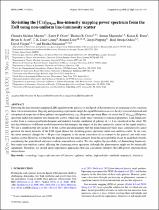| dc.contributor.author | Murmu, Chandra Shekhar | |
| dc.contributor.author | Olsen, Karen P. | |
| dc.contributor.author | Davél, Romeel | |
| dc.date.accessioned | 2023-04-12T13:05:24Z | |
| dc.date.available | 2023-04-12T13:05:24Z | |
| dc.date.issued | 2023 | |
| dc.identifier.citation | Murmu, C. S. et al. (2023). Revisiting the [C ii]158𝝁��m line-intensity mapping power spectrum from the EoR using non-uniform line-luminosity scatter. Monthly Notices of the Royal Astronomical Society, 518(2), 3074–3082. https://doi.org/10.1093/mnras/stac3304 | en_US |
| dc.identifier.issn | 1365-2966 | |
| dc.identifier.uri | https://doi.org/10.1093/mnras/stac3304 | |
| dc.identifier.uri | http://hdl.handle.net/10566/8770 | |
| dc.description.abstract | Detecting the line-intensity mapping (LIM) signal from the galaxies of the Epoch of Reionization is an emerging tool to constrain
their role in reionization. Ongoing and upcoming experiments target the signal fluctuations across the sky to reveal statistical and
astrophysical properties of these galaxies via signal statistics, e.g., the power spectrum. Here, we revisit the [Cii]158𝜇m LIM power
spectrum under non-uniform line-luminosity scatter, which has a halo-mass variation of statistical properties. Line-luminosity
scatter from a cosmological hydrodynamic and radiative transfer simulation of galaxies at 𝑧 = 6 is considered in this study. We
test the robustness of different model frameworks that interpret the impact of the line-luminosity scatter on the signal statistics.
We use a simple power-law model to fit the scatter and demonstrate that the mean luminosity-halo mass correlation fit cannot
preserve the mean intensity of the LIM signal (hence the clustering power spectrum) under non-uniform scatter. In our case,
the mean intensity changes by ∼ 48 per cent compared to the mean correlation fit in contrast to the general case with semianalytic scatter. However, we find that the prediction for the mean intensity from the most-probable fit can be modelled robustly,
considering the generalized and more realistic non-uniform scatter. We also explore the possibility of diminishing luminosity
bias under non-uniform scatter, affecting the clustering power spectrum, although this phenomenon might not be statistically
significant. Therefore, we should adopt appropriate approaches that can consistently interpret the LIM power spectrum from
observations. | en_US |
| dc.language.iso | en | en_US |
| dc.publisher | Oxford University Press | en_US |
| dc.subject | Physics | en_US |
| dc.subject | Astronomy | en_US |
| dc.subject | Cosmology | en_US |
| dc.subject | Galaxies formation | en_US |
| dc.subject | Statistics | en_US |
| dc.title | Revisiting the [C ii]158𝝁��m line-intensity mapping power spectrum from the EoR using non-uniform line-luminosity scatter | en_US |
| dc.type | Article | en_US |

